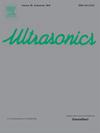Parameter optimization of interdigital transducers for high-performance acoustofluidic devices
IF 3.8
2区 物理与天体物理
Q1 ACOUSTICS
引用次数: 0
Abstract
Microfluidic actuators based on surface acoustic waves (SAWs) typically operate at frequencies below 100 MHz, often neglecting the effect of interdigital transducer (IDT) parameters on device size, cost, and actuation performance. In this paper, we aim to optimize IDT parameters to improve fluidic actuation performance while maintaining a compact size, thereby enhancing the space utilization and reducing manufacturing cost. We systematically investigate the effects of IDT parameters, including wavelength, acoustic aperture, and the number of electrode pairs on fluidic actuation and explore the underlying mechanisms. Results show that increasing the number of electrode pairs and wavelength, or reducing the acoustic aperture width, enhances fluidic actuation performance. Additionally, fluid behaviors vary significantly with frequency. Above 80 MHz, the droplet pumping exhibits a jumping motion that requires a higher power, while jetting resembles the launch of liquid droplet projectile. Below 62 MHz, the droplet pumping combines a rolling and sliding motion, with jetting following a continuous water column along the Rayleigh angle. Moreover, the ejected liquid column size is determined by the acoustic aperture width when the droplet size exceeds the aperture width. Based on these findings, we propose an optimized IDT design guideline: a wavelength range of 64 to 80 µm, 40 to 60 electrode pairs, and an acoustic aperture width of 4 to 6 mm, to achieve optimal fluidic actuation performance while maintaining a compact size for most biomedical applications.
高性能声流器件数字间换能器参数优化
基于表面声波(saw)的微流体致动器通常工作频率低于100 MHz,通常忽略了数字间换能器(IDT)参数对器件尺寸、成本和致动性能的影响。在本文中,我们的目标是优化IDT参数,在保持紧凑尺寸的同时提高流体驱动性能,从而提高空间利用率,降低制造成本。我们系统地研究了IDT参数,包括波长、声孔径和电极对数量对流体驱动的影响,并探讨了潜在的机制。结果表明,增加电极对数和波长,或减小声孔径宽度,都能提高流体驱动性能。此外,流体行为随频率变化很大。在80 MHz以上,液滴泵送呈现跳跃运动,需要更高的功率,而喷射类似于液滴抛射体的发射。在62兆赫以下,液滴泵送结合了滚动和滑动运动,并沿着瑞利角沿连续水柱喷射。此外,当液滴尺寸超过孔径宽度时,喷射液柱的尺寸由声孔径宽度决定。基于这些发现,我们提出了一种优化的IDT设计准则:波长范围为64至80µm, 40至60对电极,声孔径宽度为4至6 mm,以实现最佳的流体驱动性能,同时保持大多数生物医学应用的紧凑尺寸。
本文章由计算机程序翻译,如有差异,请以英文原文为准。
求助全文
约1分钟内获得全文
求助全文
来源期刊

Ultrasonics
医学-核医学
CiteScore
7.60
自引率
19.00%
发文量
186
审稿时长
3.9 months
期刊介绍:
Ultrasonics is the only internationally established journal which covers the entire field of ultrasound research and technology and all its many applications. Ultrasonics contains a variety of sections to keep readers fully informed and up-to-date on the whole spectrum of research and development throughout the world. Ultrasonics publishes papers of exceptional quality and of relevance to both academia and industry. Manuscripts in which ultrasonics is a central issue and not simply an incidental tool or minor issue, are welcomed.
As well as top quality original research papers and review articles by world renowned experts, Ultrasonics also regularly features short communications, a calendar of forthcoming events and special issues dedicated to topical subjects.
 求助内容:
求助内容: 应助结果提醒方式:
应助结果提醒方式:


